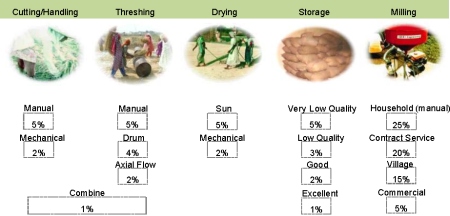by Casey Cheng and Kari A. Wozniak
If you were going to invest resources into reducing postharvest losses within a supply chain, where exactly would you invest them? Would you begin with building better storage, or perhaps buying a mechanical drier? These types of questions face farmers, managers, and practitioners around the world, and yet there is a severe lack of data to help them make a good decision.
Back in August 2013, we talked about the need for innovation in measurement for postharvest loss prevention in the article, Innovation in Measurement: Perspective and Practice. The lack of decision relevant data has long been a characteristic of postharvest loss issues and has been an on-going source of frustration to those interested in taking action to reduce postharvest loss. Recognizing this frustration, we have been exploring ways to extract information that is useful from what we know about postharvest loss.
While the lack of data is a key impediment, we also lack tools that would facilitate enhanced decision making. To advance both dialogue and practice, the ADM Institute (ADMI) has launched a prototype decision-making tool, the Postharvest Investment Tool. This tool developed by Centrec Consulting Group in collaboration with the ADMI provides a framework to foster action to reduce postharvest loss. The tool can produce reasonable estimates based on what is known about postharvest practices and expected loss percentages at various stages of a supply chain. Furthermore, the tool provides insights on how changes in practice could affect postharvest loss in both quantity and quality. With the information provided by the tool, decision makers can better evaluate the potentials of their investments.
Why Practice-Based
Traditionally, measurement of postharvest loss is conducted for specific practices on a relatively small scale, which leads to scattered data for different practices at different supply chain stages in different regions. The practice-based approach integrates the scattered data obtained from traditional measurement of postharvest loss. As shown in the figure below, loss percentages collected from secondary data can be assigned to each practice at supply chain stages. Given the amount of production, we can estimate the amount of postharvest loss.

Loss estimates by practices Credits: IRRI and Centrec
How the Postharvest Investment Tool Works
In addition to producing baseline data of postharvest loss, the tool can also help to make decisions on investments in different practices. Two types of analyses are available – practice-based analysis and regional analysis. Both analyses compare the effect of changing practices on the amount of loss in quantity and value. However, the practice-based analysis considers individual practices at each supply chain stage and the regional analysis considers all practices at each supply chain stage by assigning percentages to practices.
For example, consider a rice supply chain in District A employs traditional practices such as manual cutting, manual threshing, sun drying, very low quality storage, and household/manual milling. Decision makers in District A are thinking to invest in combines and high quality storage to reduce postharvest loss. Assuming the loss percentage of traditional practices is 5% and that of combine harvesting and high quality storage is 1%, the traditional practices would have 9.7 metric tons of loss and the new practices would have 7.5 metric tons of loss for each 1,000 metric tons of production. A similar analysis can be conducted for regional analysis by changing the percentage assigned to each practice. Detailed examples are available in the slides introducing the tool.
The tool was first presented in May 2014, at a convening of postharvest experts co-hosted by the ADMI and the Bill & Melinda Gates Foundation. Titled, “Postharvest Loss Metrics, Measurement, and Mitigation: Resolving the Unmet Needs”, the convening was a platform for cross-sector experts to discuss challenges presented by a lack of information on postharvest loss. You can read more about this event in the ADMI’s August 2014 Periodic Report.


No comments yet.